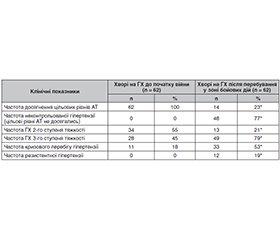Журнал «» Том 18, №2, 2025
Вернуться к номеру
Ефективність та прихильність до антигіпертензивної терапії у хворих на гіпертонічну хворобу, які перебували в зоні бойових дій у період війни
Авторы: Коваль С.М. (1), Мисниченко О.В. (1), Пенькова М.Ю. (1), Литвинова О.М. (2), Ковалевська В.Ю. (3)
(1) - Державна установа «Нацiональний iнститут терапії iменi Л.Т. Малої Національної академії медичних
наук України», м. Харків, Україна
(2) - Національний фармацевтичний університет, м. Харків, Україна
(3) - Харківський національний університет імені В.Н. Каразіна, м. Харків, Україна
Рубрики: Кардиология
Разделы: Клинические исследования
Версия для печати
Актуальність. Одним з ключових факторів, які призводять до розвитку і прогресування гіпертонічної хвороби (ГХ), є стрес. Найпотужнішою причиною виникнення стресу є війна. Показано, що в період війни у великої кількості осіб формується особлива форма гіпертензії — артеріальна гіпертензія воєнного часу. Крім артеріальної гіпертензії воєнного часу, ще одним наслідком хронічного стресу в період війн і збройних конфліктів є прогресування вже існуючої ГХ. Дуже гострими проблемами в період війни є проблеми ефективності лікування і прихильності до нього хворих на ГХ. Однак дані літератури в цьому напрямку обмежені. Мета: вивчення ефективності антигіпертензивної терапії і прихильності до неї у хворих на ГХ — цивільних осіб, які перебували в зоні бойових дій у період війни. Матеріали та методи. Обстежено 62 хворі на ГХ 2–3-го ступеня (чоловіків — 29, жінок — 33) віком від 45 до 65 років (середній вік 52,4 ± 4,3 року) — представників цивільного населення, які перебували у зоні бойових дій у період війни. Інтервал між обстеженням до війни і оглядом хворих після їх перебування в зоні бойових дій становив 8–9 місяців. Усім хворим проводили загальноклінічне лабораторне та інструментальне обстеження. Статистичний аналіз отриманих даних проведено за допомогою стандартних методів із застосуванням пакетів прикладних програм Microsoft Exсel 7.0 та SPSS 19.0. Результати. У переважної більшості (77 %) хворих на ГХ, які в період війни перебували в зоні бойових дій, відбувалось значне зниження ефективності індивідуально підібраної антигіпертензивної терапії. Вказане зниження ефективності терапії проявлялось у достовірному зниженні частоти досягнення цільових рівнів артеріального тиску, підвищенні тяжкості гіпертензії, збільшенні частоти кризового перебігу гіпертензії та резистентної форми захворювання. Зниження ефективності антигіпертензивної терапії в обстежених хворих відбувалось на тлі достовірного зниження прихильності до призначеної терапії зі 100 до 64 % (р < 0,05). Але неприхильність до терапії була причиною зниження її ефективності лише у частини хворих — 36 %. Дуже важливою причиною зниження ефективності антигіпертензивної терапії у хворих на ГХ у період війни є хронічний стрес воєнного часу, який призводить до розвитку тривожно-депресивних порушень, активації прогіпертензивних факторів і прогресування гіпертензії. Висновки. Результати дослідження вказують на необхідність ретельного моніторування ступеня контрольованості гіпертензії та прихильності до антигіпертензивної терапії з метою забезпечення своєчасної корекції вказаних показників і профілактики прогресування гіпертензії та розвитку її ускладнень.
Background. One of the key factors leading to the development and progression of hypertensive disease (HD) is stress. The most powerful cause of stress is war. It has been shown that during wartime, many people develop a specific form — wartime hypertension. In addition to wartime hypertension, another consequence of chronic stress during wars and armed conflicts is the progression of pre-existing HD. The problems of effectiveness and adherence to treatment of patients with HD are very acute during wartime. However, the literature in this area is limited. Purpose: to study the effectiveness of antihypertensive therapy and adherence to it in patients with HD — civilians who were in a combat zone during the war. Materials and methods. Sixty-two patients (29 men, 33 women) aged 45 to 65 years (mean of 52.4 ± 4.3 years) with HD degree 2–3, representatives of the civilian population who were in the combat zone during the war, were examined. The interval between the examination before the war and after stay in the combat zone was 8–9 months. All patients underwent general clinical laboratory and instrumental examination. Statistical analysis of the data obtained was carried out using standard methods with the application packages Microsoft Excel 7.0 and SPSS 19.0. Results. The vast majority (77 %) of patients with HD who were in the combat zone during the war experienced a significant decrease in the effectiveness of individually selected antihypertensive therapy. It was manifested in a significantly reduced frequency of achieving target blood pressure levels, an increase in the severity of hypertension, in the frequency of hypertensive crises and resistant forms of the disease. A decreased effectiveness of antihypertensive therapy in the examined patients occurred against the background of a significant decrease in adherence to the prescribed therapy from 100 to 64 % (p < 0.05). However, non-adherence was the reason for a decrease in therapy effectiveness only in some patients (36 %). Very important reasons for a decrease in the effectiveness of antihypertensive therapy in patients with HD during the war are chronic wartime stress, which leads to the development of anxiety and depressive disorders, activation of prohypertensive factors, and progression of hypertension. Conclusions. The results of the study indicate the need for careful monitoring of the degree of hypertension control and adherence to antihypertensive therapy in order to ensure timely correction of these indicators, prevent the progression of hypertension and the development of its complications.
гіпертонічна хвороба; війна; антигіпертензивна терапія; ефективність терапії; прихильність до терапії
hypertensive disease; war; antihypertensive therapy; therapy effectiveness; adherence to therapy

